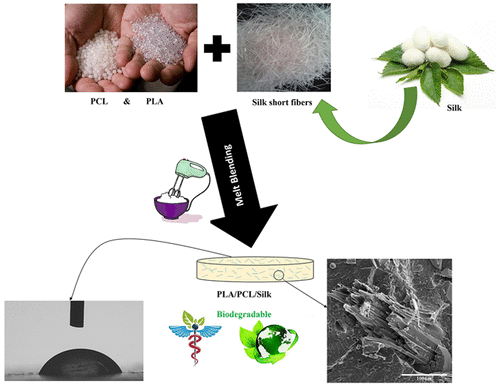当前位置:
X-MOL 学术
›
Biomacromolecules
›
论文详情
Our official English website, www.x-mol.net, welcomes your
feedback! (Note: you will need to create a separate account there.)
Preparation and Characterization of Composite Blends Based on Polylactic Acid/Polycaprolactone and Silk
Biomacromolecules ( IF 5.5 ) Pub Date : 2018-10-23 00:00:00 , DOI: 10.1021/acs.biomac.8b01254 Shiva Balali 1 , Seyed Mohammad Davachi 1, 2 , Razi Sahraeian 3 , Behzad Shiroud Heidari 4, 5, 6 , Javad Seyfi 7 , Iman Hejazi 4
Biomacromolecules ( IF 5.5 ) Pub Date : 2018-10-23 00:00:00 , DOI: 10.1021/acs.biomac.8b01254 Shiva Balali 1 , Seyed Mohammad Davachi 1, 2 , Razi Sahraeian 3 , Behzad Shiroud Heidari 4, 5, 6 , Javad Seyfi 7 , Iman Hejazi 4
Affiliation

|
Silk-reinforced polylactic acid/poly ε-caprolactone composites containing 1–7 wt % of silk fibers were fabricated through the melt-mixing method. The composites were then characterized by implementing Fourier transform infrared (FTIR), differential scanning calorimetry (DSC) and rheometry to investigate functional groups, thermal properties, rheological properties, and intrinsic viscosities of each composite. The crystallinity of the composites was found to decrease upon addition of silk, while, both storage modulus (G′) and loss modulus (G″) were increased which is an indication of interface bonding between the polymer and silk. The composite containing 5% silk fiber (PLACLS5) showed the optimum results. The composites’ morphological analysis was conducted by scanning electron micrograph coupled with energy dispersive X-ray (SEM-EDX) mapping to assess the fiber dispersion in the composite matrix. The contact angle measurements and in vitro degradation were performed to evaluate the hydrophilicity, free surface energy, and hydrolytic degradation of the composites. The results implied that addition of higher contents of silk fiber could reduce the degradation duration of the composites, which is due to the high hydrophilicity of the fiber, uniform fiber dispersion within the matrix, the porous structure, and consequently, the hydrophilic behavior of the composites. These composites can be great alternatives for both soft and hard tissue engineering applications.
中文翻译:

聚乳酸/聚己内酯与丝绸混合共混物的制备与表征
通过熔融混合法制备了含丝纤维含量为1-7 wt%的丝增强聚乳酸/聚ε-己内酯复合材料。然后通过实施傅立叶变换红外光谱(FTIR),差示扫描量热法(DSC)和流变法对复合材料进行表征,以研究每种复合材料的官能团,热性质,流变性质和固有粘度。发现添加丝后复合材料的结晶度降低,而储能模量(G ')和损耗模量(G'')增加,这表明聚合物与丝绸之间存在界面键合。含5%蚕丝纤维的复合材料(PLACLS5)显示出最佳效果。通过扫描电子显微镜和能量色散X射线(SEM-EDX)映射进行复合材料的形态分析,以评估纤维在复合材料基体中的分散性。进行接触角测量和体外降解以评估复合材料的亲水性,自由表面能和水解降解。结果表明,较高含量的蚕丝纤维的添加可以减少复合材料的降解时间,这是由于纤维的高亲水性,纤维在基体内的均匀分散,多孔结构以及因此而导致的亲水性。复合材料。
更新日期:2018-10-23
中文翻译:

聚乳酸/聚己内酯与丝绸混合共混物的制备与表征
通过熔融混合法制备了含丝纤维含量为1-7 wt%的丝增强聚乳酸/聚ε-己内酯复合材料。然后通过实施傅立叶变换红外光谱(FTIR),差示扫描量热法(DSC)和流变法对复合材料进行表征,以研究每种复合材料的官能团,热性质,流变性质和固有粘度。发现添加丝后复合材料的结晶度降低,而储能模量(G ')和损耗模量(G'')增加,这表明聚合物与丝绸之间存在界面键合。含5%蚕丝纤维的复合材料(PLACLS5)显示出最佳效果。通过扫描电子显微镜和能量色散X射线(SEM-EDX)映射进行复合材料的形态分析,以评估纤维在复合材料基体中的分散性。进行接触角测量和体外降解以评估复合材料的亲水性,自由表面能和水解降解。结果表明,较高含量的蚕丝纤维的添加可以减少复合材料的降解时间,这是由于纤维的高亲水性,纤维在基体内的均匀分散,多孔结构以及因此而导致的亲水性。复合材料。











































 京公网安备 11010802027423号
京公网安备 11010802027423号